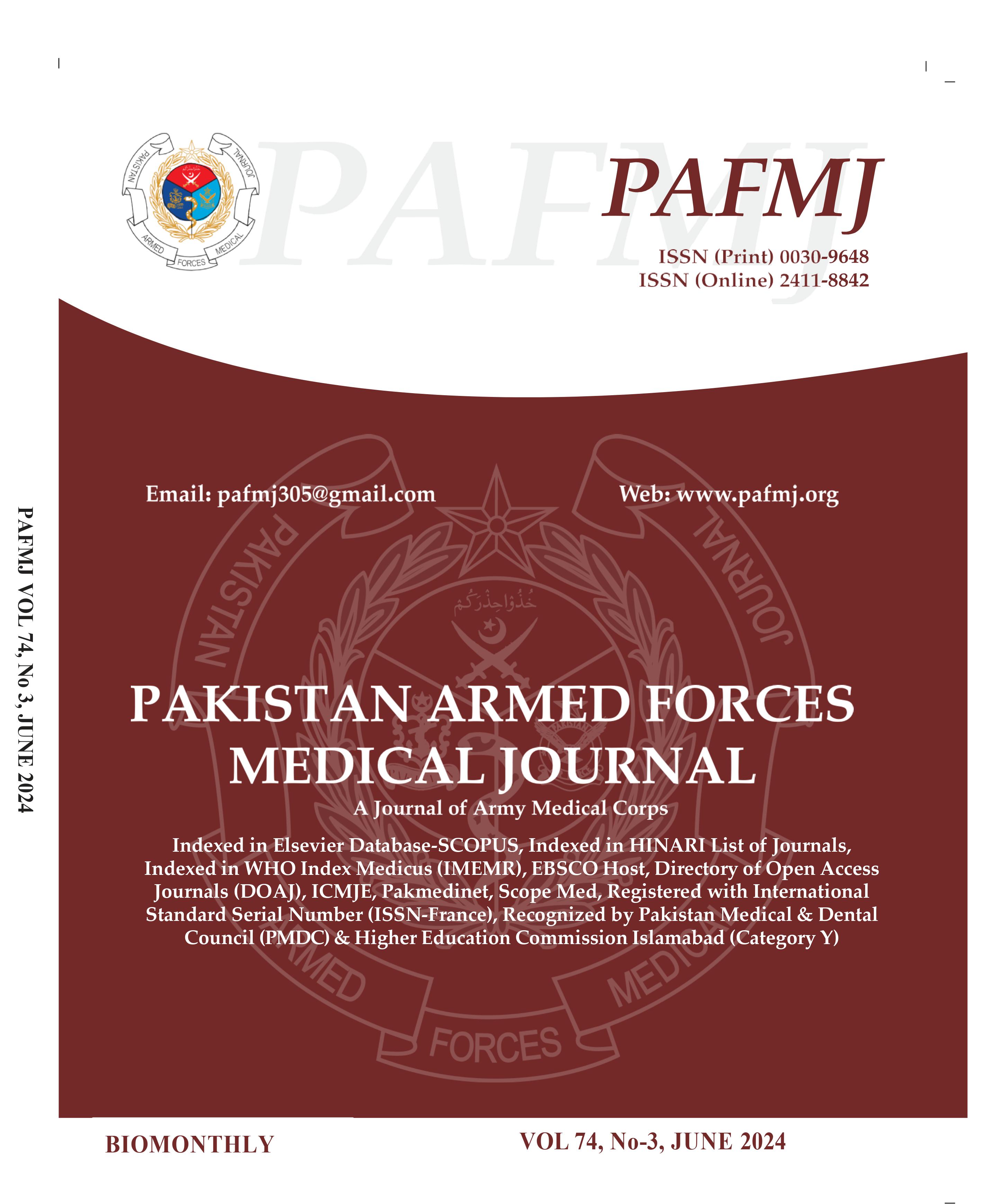Delays in Arterio-Venous Fistula Formation Among Patients With Chronic Kidney Disease; A Comparative Analysis Between Patient and Healthcare Related Factorstween Patient and Healthcare Related Factors
DOI:
https://doi.org/10.51253/pafmj.v74i3.6664Keywords:
Arterio-venous fistula, Chronic kidney disease, Hemodialysis.Abstract
Objective: To evaluate the factors associated with delay in arterio-venous fistula formation among the patients with chronic kidney disease on hemodialysis.
Study Design: Comparative cross-sectional study.
Place and Duration of Study: Combined Military Hospital, Lahore Pakistan, from Jan to Dec 2020.
Methodology: All patients above 18 years of age with chronic kidney disease on maintenance hemodialysis (end stage renal disease) were inducted in the study. Patients requiring hemodialysis for acute kidney injury were excluded from the study. Patients were interviewed face-to-face about their socio-demographic variables, cause of delay and mean delay time from diagnosis to Arterio-venous fistula formation.
Results: Out of 292 patients, 228 patients (76%) had a delay in arterio-venous fistula and first dialysis through double lumen catheter. The mean age of these patients was 59.05 years with 78.1% males. The mean delay of these patients was 60.63+26.832 days. Patient unwillingness and lack of awareness of deteriorating renal disease were the commonest factors (35%) in patient related factors and delayed surgical appointment being commonest (49.1%) in health care associated factors. The longest delay time was 69.04±25.759 months which was associated with delayed surgical appointment (p<0.001). Monthly income, gender and age had significant impact on different factors included in this study.
Conclusion: The study identified that differences in Arterio-venous fistula maturation with respect to age, gender and socio-demographic factors were significant. Timely formation of Arterio-venous fistula in patients with chronic kidney disease is the most favourable approach to establish vascular access for hemodialysis and improves outcome.
Downloads
References
Okorie C, Annan R, Turkey H, Akhtar N, Gray F, Hamdy K, et al. Epidemiology and management of chronic renal failure: a global public health problem. Biostatistics Epidemiol Int J 2018; 1(1): 11–16. https://doi.org/10.30881/beij.00005
Abubakar II, Tillmann T, Banerjee A. Global, regional, and national age-sex specific all-cause and cause-specific mortality for 240 causes of death, 1990-2013: a systematic analysis for the global burden of disease study 2013. Lancet 2015; 385(9963): 117–171. https://doi.org/10.1016/S0140-6736(14)61682-2
Vadakedath S, Kandi V. Dialysis: a review of the mechanisms underlying complications in the management of chronic renal failure. Cureus 2017; 9(8): 1603.
https://doi.org/10.7759/cureus.1603
Smith GE, Gohil R, Chetter IC. Factors affecting the patency of arteriovenous fistulas for dialysis access. J Vasc Surg 2012; 55(3): 849-855. https://doi.org/10.1016/j.jvs.2011.08.091
Al-Jaishi AA, Oliver MJ, Thomas SM, Lok CE, Zhang JC, Garg AX, et al. Patency rates of the arteriovenous fistula for hemodialysis: a systematic review and meta-analysis. Am J Kidney Dis 2014; 63(3): 464-478.
https://doi.org/10.1053/j.ajkd.2013.08.023
Sequeira A, Naljayan M, Vachharajani TJ. Vascular access guidelines: summary, rationale, and controversies. Tech Vasc Interv Radiol 2017; 20(1): 2-8.
https://doi.org/10.1053/j.tvir.2016.12.001
Allon M, Robbin ML. Increasing arteriovenous fistulas in hemodialysis patients: problems and solutions. Kidney Int 2002; 62(4): 1109-24.
https://doi.org/10.1046/j.1523-1755.2002.00524.x
Mahmood SN, Mukhtar KN, Iqbal N, Umair SF. Pre dialysis care and types of vascular access employed in incident hemodialysis patients: A study from Pakistan. Pak J Med Sci 2013; 29(3): 828. https://doi.org/10.12669/pjms.293.3690
Rashid N, Aamer M, Malik U, Arif N, Akram MW, Irshad A. Arteriovenous Fistula (AVF) Self-Care: A Study at a Tertiary Care Hospital in Lahore, Pakistan. Ann King Edward Med Uni 2018; 24(1): 706-712.
Baig ZF, Mehmood A, Saeed S, Raja KM, Khan MNA, Murtaza B. Early versus Late Arteriovenous Fistulae: Impact on Failure Rate. J Ayub Med Coll Abbottabad 2010; 22(3): 179-181.
Hasan M, Sutradhar I, Gupta RD, Sarker M. Prevalence of chronic kidney disease in South Asia: a systematic review. BMC Nephrol 2018; 19(1): 291.
https://doi.org/10.1186/s12882-018-1072-1074
Alfarhan MA, Almatrafi SA, Alqaseer SM, Albkiry YA, AlSayyari A. Causes of delay in creating permanent vascular access in hemodialysis patients. Saudi J Kidney Dis Transpl 2020; 31(6): 1217-1224.
https://doi.org/10.4103/1319-2442.308602
Yang S, Lok C, Arnold R, Rajan D, Glickman M. Comparison of post-creation procedures and costs between surgical and an endovascular approach to arteriovenous fistula creation. J Vasc Access 2017; 18(2): 8-14. https://doi.org/10.5301/jva.5000645
Jemcov TK. Morphologic and functional vessels characteristics assessed by ultrasonography for prediction of radiocephalic fistula maturation. J Vasc Access 2013; 14(4): 356-363. https://doi.org/10.5301/jva.5000118
Salmela B, Hartman J, Peltonen S, Alback A, Lassila R. Thrombophilia and arteriovenous fistula survival in ESRD. Clin J Am Soc Nephrol 2013; 8(6): 962-968.
https://doi.org/10.2215/CJN.09340912
Renaud CJ, Pei JH, Lee EJ, Robless PA, Vathsala A. Comparative outcomes of primary autogenous fistulas in elderly, multiethnic Asian hemodialysis patients. J Vasc Surg 2012; 56(2): 433-439. https://doi.org/10.1016/j.jvs.2012.02.035
Avorn J, Winkelmayer WC, Bohn RL, Levin R, Glynn RJ, Levy E, et al. Delayed nephrologist referral and inadequate vascular access in patients with advanced chronic kidney failure. J Clin Epidemiol 2002; 55(7): 711-716.
https://doi.org/10.1016/S0895-4356(02)00419-9
Kim YO, Choi YJ, Kim JI, Kim YS, Kim BS, Park CW, et al. The impact of intima-media thickness of radial artery on early failure of radiocephalic arteriovenous fistula in hemodialysis patients. J Korean Med Sci 2006; 21(2): 284-289.
https://doi.org/10.3346/jkms.2006.21.2.284
Siddiqui MA, Ashraff S, Carline T. Maturation of arteriovenous fistula: Analysis of key factors. Kidney Res Clin Pract 2017; 36(4): 318.
https://doi.org/10.23876/j.krcp.2017.36.4.318
Woodside KJ, Bell S, Mukhopadhyay P, Repeck KJ, Robinson IT, Eckard AR, et al. Arteriovenous fistula maturation in prevalent hemodialysis patients in the United States: a national study. Am J Kidney Dis 2018; 71(6): 793-801.
Downloads
Published
Issue
Section
License
Copyright (c) 2024 Muhammad Arslan Javaid, Zahid Farooq Baig, Imran Ahmed, Nisar Ahmed, Ubaid Tanseer, Muhammad Arslan Javed, Muhammad Siddique

This work is licensed under a Creative Commons Attribution-NonCommercial 4.0 International License.















